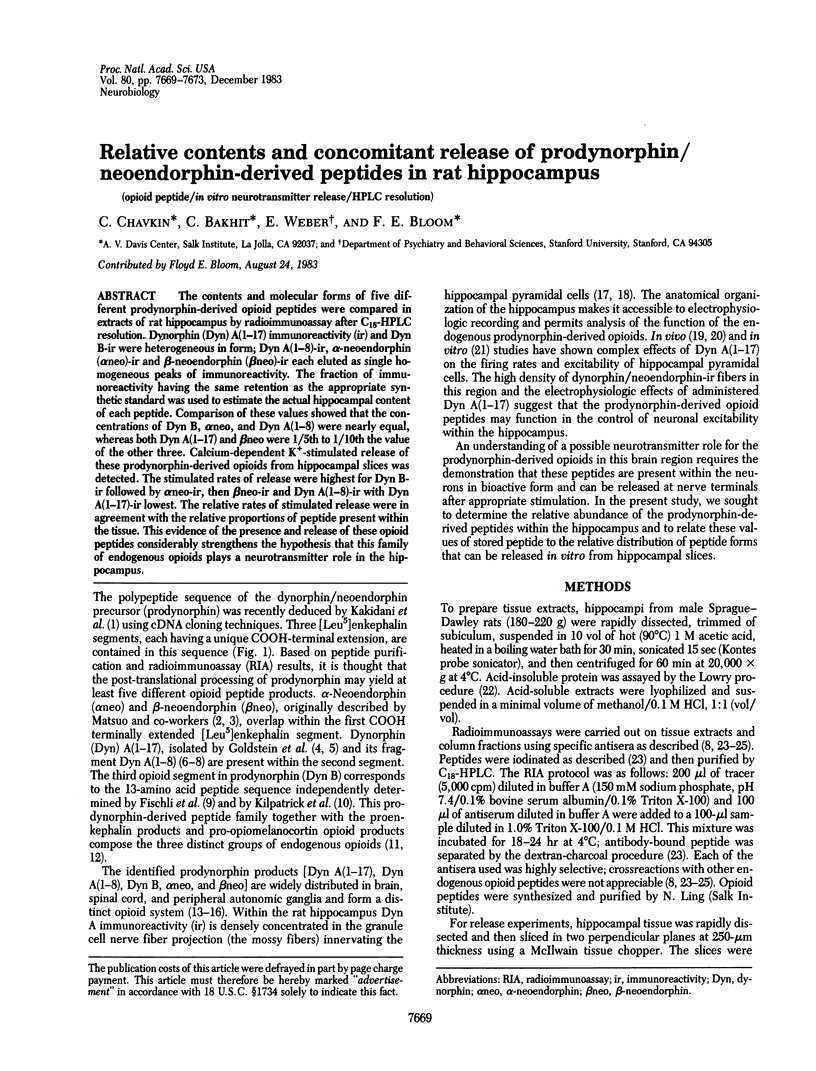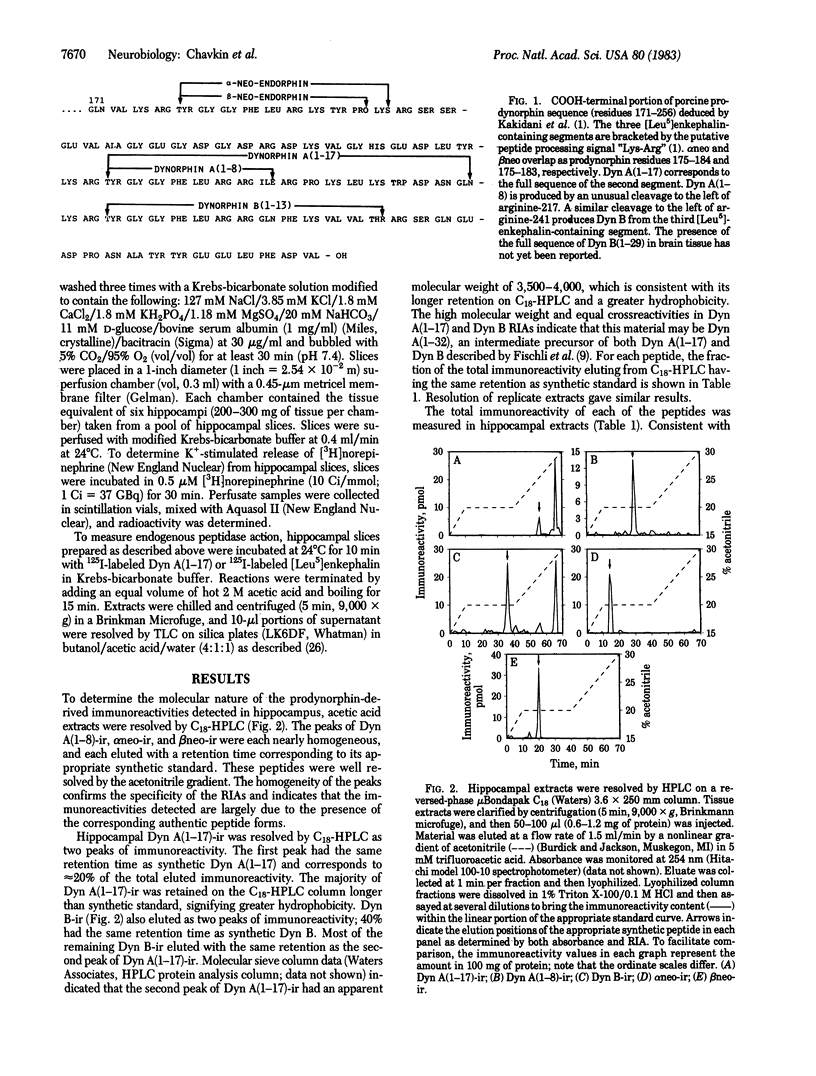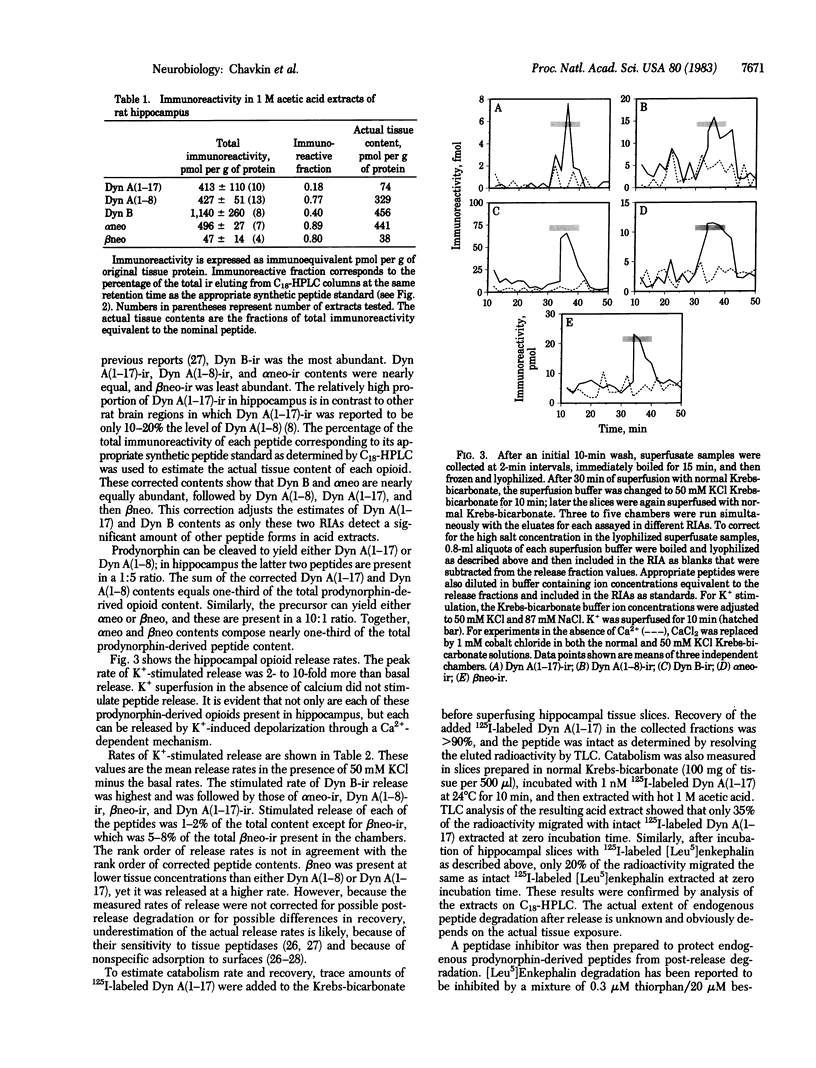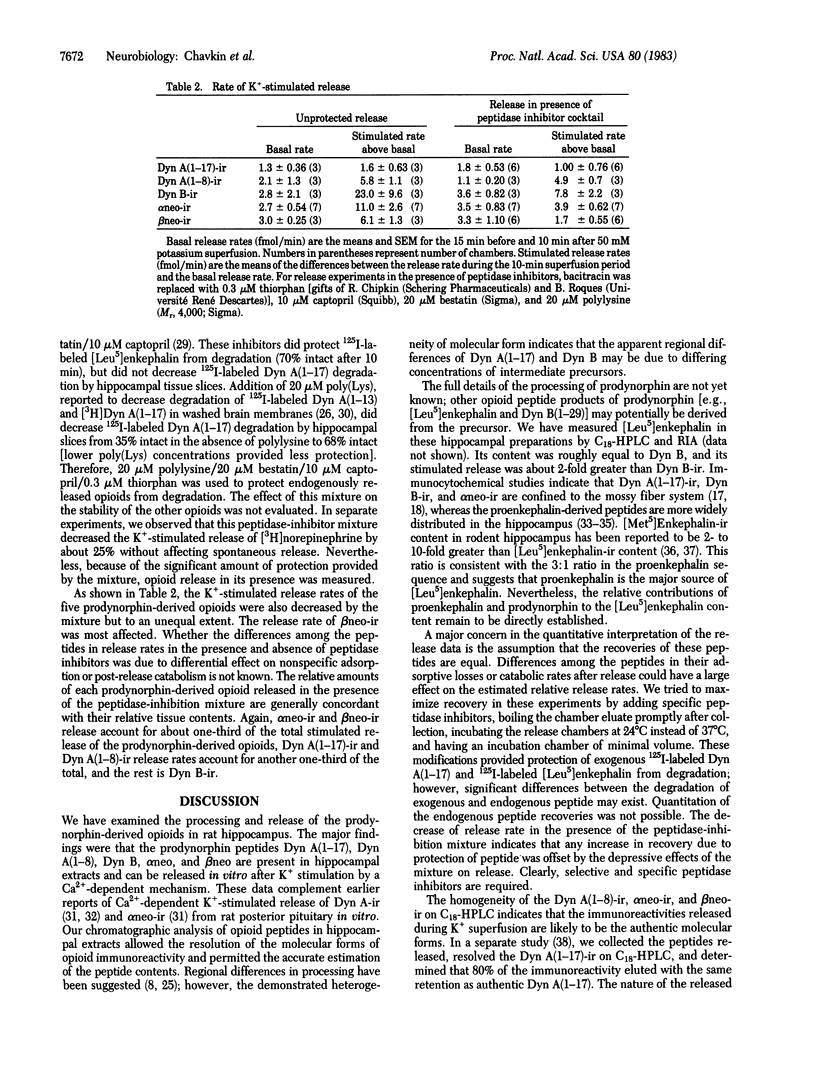Abstract
The contents and molecular forms of five different prodynorphin-derived opioid peptides were compared in extracts of rat hippocampus by radioimmunoassay after C18-HPLC resolution. Dynorphin (Dyn) A(1-17) immunoreactivity (ir) and Dyn B-ir were heterogeneous in form; Dyn A(1-8)-ir, alpha-neoendorphin (alpha neo)-ir and beta-neoendorphin (beta neo)-ir each eluted as single homogeneous peaks of immunoreactivity. The fraction of immunoreactivity having the same retention as the appropriate synthetic standard was used to estimate the actual hippocampal content of each peptide. Comparison of these values showed that the concentrations of Dyn B, alpha neo, and Dyn A(1-8) were nearly equal, whereas both Dyn A(1-17) and beta neo were 1/5th to 1/10th the value of the other three. Calcium-dependent K+-stimulated release of these prodynorphin-derived opioids from hippocampal slices was detected. The stimulated rates of release were highest for Dyn B-ir followed by alpha neo-ir, then beta neo-ir and Dyn A(1-8)-ir with Dyn A(1-17)-ir lowest. The relative rates of stimulated release were in agreement with the relative proportions of peptide present within the tissue. This evidence of the presence and release of these opioid peptides considerably strengthens the hypothesis that this family of endogenous opioids plays a neurotransmitter role in the hippocampus.
Full text
PDF




Selected References
These references are in PubMed. This may not be the complete list of references from this article.
- Anhut H., Knepel W. Release of dynorphin-like immunoreactivity of rat neurohypophysis in comparison to vasopressin after various stimuli in vitro and in vivo. Neurosci Lett. 1982 Aug 16;31(2):159–164. doi: 10.1016/0304-3940(82)90109-4. [DOI] [PubMed] [Google Scholar]
- Bloch B., Baird A., Ling N., Benoit R., Guillemin R. Immunohistochemical evidence that brain enkephalins arise from a precursor similar to adrenal preproenkephalin. Brain Res. 1983 Mar 21;263(2):251–257. doi: 10.1016/0006-8993(83)90317-7. [DOI] [PubMed] [Google Scholar]
- Bloom F. E. The endorphins: a growing family of pharmacologically pertinent peptides. Annu Rev Pharmacol Toxicol. 1983;23:151–170. doi: 10.1146/annurev.pa.23.040183.001055. [DOI] [PubMed] [Google Scholar]
- Chavkin C., Bakhit C., Bloom F. E. Evidence for dynorphin-A as a neurotransmitter in rat hippocampus. Life Sci. 1983;33 (Suppl 1):13–16. doi: 10.1016/0024-3205(83)90432-0. [DOI] [PubMed] [Google Scholar]
- Cone R. I., Goldstein A. A specific radioimmunoassay for the opioid peptide dynorphin B in neural tissues. Neuropeptides. 1982 Dec;3(2):97–106. doi: 10.1016/0143-4179(82)90005-1. [DOI] [PubMed] [Google Scholar]
- Corbett A. D., Paterson S. J., McKnight A. T., Magnan J., Kosterlitz H. W. Dynorphin and dynorphin are ligands for the kappa-subtype of opiate receptor. Nature. 1982 Sep 2;299(5878):79–81. doi: 10.1038/299079a0. [DOI] [PubMed] [Google Scholar]
- Cox B. M. Endogenous opioid peptides: a guide to structures and terminology. Life Sci. 1982 Oct 18;31(16-17):1645–1658. doi: 10.1016/0024-3205(82)90179-5. [DOI] [PubMed] [Google Scholar]
- Fischli W., Goldstein A., Hunkapiller M. W., Hood L. E. Isolation and amino acid sequence analysis of a 4,000-dalton dynorphin from porcine pituitary. Proc Natl Acad Sci U S A. 1982 Sep;79(17):5435–5437. doi: 10.1073/pnas.79.17.5435. [DOI] [PMC free article] [PubMed] [Google Scholar]
- Gall C., Brecha N., Karten H. J., Chang K. J. Localization of enkephalin-like immunoreactivity to identified axonal and neuronal populations of the rat hippocampus. J Comp Neurol. 1981 May 10;198(2):335–350. doi: 10.1002/cne.901980211. [DOI] [PubMed] [Google Scholar]
- Ghazarossian V. E., Chavkin C., Goldstein A. A specific radioimmunoassay for the novel opioid peptide dynorphin. Life Sci. 1980 Jul 7;27(1):75–86. doi: 10.1016/0024-3205(80)90021-1. [DOI] [PubMed] [Google Scholar]
- Goldstein A., Fischli W., Lowney L. I., Hunkapiller M., Hood L. Porcine pituitary dynorphin: complete amino acid sequence of the biologically active heptadecapeptide. Proc Natl Acad Sci U S A. 1981 Nov;78(11):7219–7223. doi: 10.1073/pnas.78.11.7219. [DOI] [PMC free article] [PubMed] [Google Scholar]
- Goldstein A., Tachibana S., Lowney L. I., Hunkapiller M., Hood L. Dynorphin-(1-13), an extraordinarily potent opioid peptide. Proc Natl Acad Sci U S A. 1979 Dec;76(12):6666–6670. doi: 10.1073/pnas.76.12.6666. [DOI] [PMC free article] [PubMed] [Google Scholar]
- Gruol D. L., Chavkin C., Valentino R. J., Siggins G. R. Dynorphin-A alters the excitability of pyramidal neurons of the rat hippocampus in vitro. Life Sci. 1983;33 (Suppl 1):533–536. doi: 10.1016/0024-3205(83)90558-1. [DOI] [PubMed] [Google Scholar]
- Henriksen S. J., Chouvet G., Bloom F. E. In vivo cellular responses to electrophoretically applied dynorphin in the rat hippocampus. Life Sci. 1982 Oct 18;31(16-17):1785–1788. doi: 10.1016/0024-3205(82)90210-7. [DOI] [PubMed] [Google Scholar]
- Hong J. S., Schmid R. Intrahippocampal distribution of Met5-enkephalin. Brain Res. 1981 Feb 2;205(2):415–418. doi: 10.1016/0006-8993(81)90353-x. [DOI] [PubMed] [Google Scholar]
- Kakidani H., Furutani Y., Takahashi H., Noda M., Morimoto Y., Hirose T., Asai M., Inayama S., Nakanishi S., Numa S. Cloning and sequence analysis of cDNA for porcine beta-neo-endorphin/dynorphin precursor. Nature. 1982 Jul 15;298(5871):245–249. doi: 10.1038/298245a0. [DOI] [PubMed] [Google Scholar]
- Kangawa K., Minamino N., Chino N., Sakakibara S., Matsuo H. The complete amino acid sequence of alpha-neo-endorphin. Biochem Biophys Res Commun. 1981 Apr 15;99(3):871–878. doi: 10.1016/0006-291x(81)91244-4. [DOI] [PubMed] [Google Scholar]
- Kilpatrick D. L., Wahlstrom A., Lahm H. W., Blacher R., Udenfriend S. Rimorphin, a unique, naturally occurring [Leu]enkephalin-containing peptide found in association with dynorphin and alpha-neo-endorphin. Proc Natl Acad Sci U S A. 1982 Nov;79(21):6480–6483. doi: 10.1073/pnas.79.21.6480. [DOI] [PMC free article] [PubMed] [Google Scholar]
- LOWRY O. H., ROSEBROUGH N. J., FARR A. L., RANDALL R. J. Protein measurement with the Folin phenol reagent. J Biol Chem. 1951 Nov;193(1):265–275. [PubMed] [Google Scholar]
- Masukawa L. M., Prince D. A. Enkephalin inhibition of inhibitory input to CA1 and CA3 pyramidal neurons in the hippocampus. Brain Res. 1982 Oct 14;249(2):271–280. doi: 10.1016/0006-8993(82)90061-0. [DOI] [PubMed] [Google Scholar]
- McGinty J. F., Henriksen S. J., Goldstein A., Terenius L., Bloom F. E. Dynorphin is contained within hippocampal mossy fibers: immunochemical alterations after kainic acid administration and colchicine-induced neurotoxicity. Proc Natl Acad Sci U S A. 1983 Jan;80(2):589–593. doi: 10.1073/pnas.80.2.589. [DOI] [PMC free article] [PubMed] [Google Scholar]
- Minamino N., Kangawa K., Chino N., Sakakibara S., Matsuo H. Beta-neo-endorphin, a new hypothalamic "big" Leu-enkephalin of porcine origin: its purification and the complete amino acid sequence. Biochem Biophys Res Commun. 1981 Apr 15;99(3):864–870. doi: 10.1016/0006-291x(81)91243-2. [DOI] [PubMed] [Google Scholar]
- Minamino N., Kangawa K., Fukuda A., Matsuo H., Iagarashi M. A new opioid octapeptide related to dynorphin from porcine hypothalamus. Biochem Biophys Res Commun. 1980 Aug 29;95(4):1475–1481. doi: 10.1016/s0006-291x(80)80063-5. [DOI] [PubMed] [Google Scholar]
- Orrego F. Criteria for the identification of central neurotransmitters, and their application to studies with some nerve tissue preparations in vitro. Neuroscience. 1979;4(8):1037–1057. doi: 10.1016/0306-4522(79)90186-6. [DOI] [PubMed] [Google Scholar]
- Seizinger B. R., Höllt V., Herz A. Evidence for the occurrence of the opioid octapeptide dynorphin-(1-8) in the neurointermediate pituitary of rats. Biochem Biophys Res Commun. 1981 Sep 16;102(1):197–205. doi: 10.1016/0006-291x(81)91507-2. [DOI] [PubMed] [Google Scholar]
- Seizinger B. R., Maysinger D., Höllt V., Grimm C., Herz A. Concomitant neonatal development and in vitro release of dynorphin and alpha-neo-endorphin. Life Sci. 1982 Oct 18;31(16-17):1757–1760. doi: 10.1016/0024-3205(82)90203-x. [DOI] [PubMed] [Google Scholar]
- Vincent S. R., Hökfelt T., Christensson I., Terenius L. Dynorphin-immunoreactive neurons in the central nervous system of the rat. Neurosci Lett. 1982 Nov 30;33(2):185–190. doi: 10.1016/0304-3940(82)90249-x. [DOI] [PubMed] [Google Scholar]
- Walker J. M., Moises H. C., Coy D. H., Baldrighi G., Akil H. Nonopiate effects of dynorphin and des-Tyr-dynorphin. Science. 1982 Dec 10;218(4577):1136–1138. doi: 10.1126/science.6128791. [DOI] [PubMed] [Google Scholar]
- Watson S. J., Khachaturian H., Akil H., Coy D. H., Goldstein A. Comparison of the distribution of dynorphin systems and enkephalin systems in brain. Science. 1982 Dec 10;218(4577):1134–1136. doi: 10.1126/science.6128790. [DOI] [PubMed] [Google Scholar]
- Watson S. J., Khachaturian H., Taylor L., Fischli W., Goldstein A., Akil H. Pro-dynorphin peptides are found in the same neurons throughout rat brain: immunocytochemical study. Proc Natl Acad Sci U S A. 1983 Feb;80(3):891–894. doi: 10.1073/pnas.80.3.891. [DOI] [PMC free article] [PubMed] [Google Scholar]
- Weber E., Barchas J. D. Immunohistochemical distribution of dynorphin B in rat brain: relation to dynorphin A and alpha-neo-endorphin systems. Proc Natl Acad Sci U S A. 1983 Feb;80(4):1125–1129. doi: 10.1073/pnas.80.4.1125. [DOI] [PMC free article] [PubMed] [Google Scholar]
- Weber E., Evans C. J., Barchas J. D. Predominance of the amino-terminal octapeptide fragment of dynorphin in rat brain regions. Nature. 1982 Sep 2;299(5878):77–79. doi: 10.1038/299077a0. [DOI] [PubMed] [Google Scholar]
- Weber E., Evans C. J., Chang J. K., Barchas J. D. Brain distributions of alpha-neo-endorphin and beta-neo-endorphin: evidence for regional processing differences. Biochem Biophys Res Commun. 1982 Sep 16;108(1):81–88. doi: 10.1016/0006-291x(82)91834-4. [DOI] [PubMed] [Google Scholar]
- Weber E., Roth K. A., Barchas J. D. Immunohistochemical distribution of alpha-neo-endorphin/dynorphin neuronal systems in rat brain: evidence for colocalization. Proc Natl Acad Sci U S A. 1982 May;79(9):3062–3066. doi: 10.1073/pnas.79.9.3062. [DOI] [PMC free article] [PubMed] [Google Scholar]
- Williams R. G., Dockray G. J. Distribution of enkephalin-related peptides in rat brain: immunohistochemical studies using antisera to met-enkephalin and met-enkephalin Arg6Phe7. Neuroscience. 1983 Jul;9(3):563–586. doi: 10.1016/0306-4522(83)90175-6. [DOI] [PubMed] [Google Scholar]
- Zieglgänsberger W., French E. D., Siggins G. R., Bloom F. E. Opioid peptides may excite hippocampal pyramidal neurons by inhibiting adjacent inhibitory interneurons. Science. 1979 Jul 27;205(4404):415–417. doi: 10.1126/science.451610. [DOI] [PubMed] [Google Scholar]


